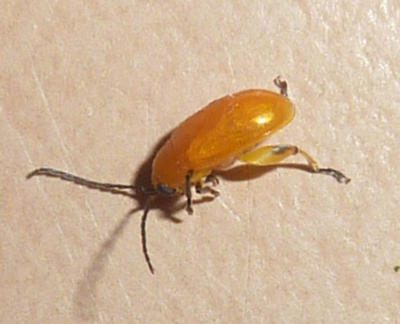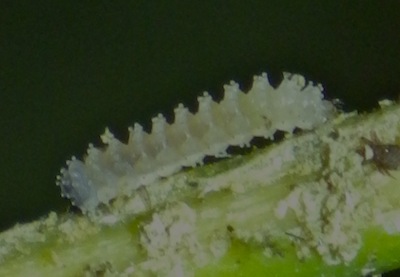Yellow-tibia Parchicola Flea Beetle (Parchicola "yellow tibia")
The Yellow-tibia Parchicola flea beetle was discovered as a cryptic species using genetic "barcoding" analysis. See notes on the Black-tibia Parchicola species for this history.
The Pa. "yellow tibia" are dominant on P. oerstedii, but may also be found on P. ambigua, P. vitifolia, P. quadrangularis and even more rarely on species of Decaloba such as P. auriculata. This pattern is analogous to Heliconius hecale and H. ismenius, preferring subgenus Passiflora, but sometimes using Decaloba. It may be that, as proposed for Heliconius, the ability to consume subgenus Passiflora pre-adapts this species for eating Decaloba species.
These flea beetles became rarer during the rainy season in November and December 2012, and then numbers rose again in March and April, 2013. They have been consistently common in late 2013 and early 2014. In August 2015 after two months of intense rainy conditions, I did not see any on P. oerstedii or P. ambigua. They did recover on P. oerstedii during October.
The majority of all Yellow-tibia Parchicola observations are from P. oerstedii, and populations of yellow-tibia in isolation cages with this plant have been found to reproduce. In an attempt to isolate and describe the juvenile stages of this species, 9 adult YT were put in a 2x2x3 foot cage with 2 potted P. oerstedii plants. This was done in early December, 2013. By January 11, 2014, new adults were emerging into the cage. Close examination of the potted plants revealed eggs under the older leaves, larvae feeding on the basal stem near ground level, and one pupa in the soil beneath the stem. The eggs were laid in groups of 8-12, arranged at random under the leaves. I have also found eggs under older P. oerstedii leaves on wild plants on three separate occasions. Eggs are very long and thin (about 5:1 ratio), and have a textured surface. Larvae have the same "hill and valley" rounded protuberances as other flea beetle larvae (Red Ptocadica, for example), except that at the crown of each protuberance there are 1-3 tiny spheres on short stalks. The spheres are patterned and seem to be made of cuticle; they are not liquid droplets, although they may contain liquid. The function of these "balloon organs" seems to be unknown. Larvae probably (I have not yet seen this) walk down the stem toward the base of the plant and begin feeding on the stem or the superficial rootlets. They chew the green epidermis of the stem as well as the woody parts, but avoid the hard core at the center.

This specimen also shows the yellow hind tibia. The fore and middle tibia are always black, distinguishing this species from the yellow-legged Parchicola DF2 with no black leg parts.
